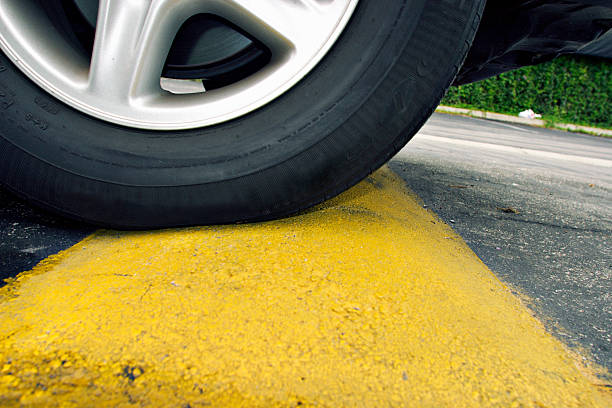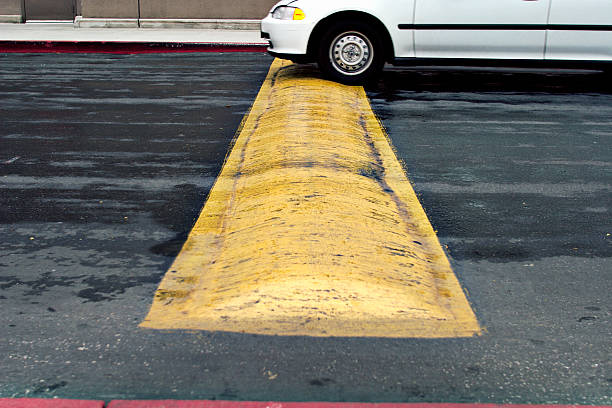Choosing the Right Speed Bumps for Asphalt Roads: Materials, Installation, and Benefits
Speed bumps are vital traffic calming measures used on asphalt roads to enhance safety, control vehicle speed, and improve traffic flow. Selecting the appropriate speed bumps for asphalt surfaces involves considerations of materials, installation methods, and the benefits they bring to various road environments. In this comprehensive guide, we explore the factors involved in choosing the right speed bumps for asphalt roads, highlighting their materials, installation techniques, and the significant advantages they offer in enhancing road safety and efficiency.
Importance of Speed Bumps for Asphalt Roads
Speed bumps for asphalt roads play a critical role in traffic management and safety. They are designed to:
- Control Vehicle Speed: By forcing drivers to slow down, speed bumps reduce the risk of accidents and improve pedestrian safety in residential areas, school zones, parking lots, and other high-traffic environments.
- Enhance Traffic Calming: Speed bumps effectively calm traffic flow by encouraging compliance with speed limits and promoting a safer driving environment for all road users.
- Minimize Noise and Pollution: Slower speeds result in reduced vehicle noise and emissions, contributing to a quieter and cleaner neighborhood or commercial area.
Types of Speed Bumps for Asphalt Roads
- Traditional Speed Bumps: These are raised sections of asphalt or other materials that extend across the width of the road. Traditional speed bumps typically have a height of 3 to 4 inches and are effective in reducing vehicle speed.
- Speed Humps: Similar to speed bumps but with a more gradual incline, speed humps span a greater length and offer a smoother ride at lower speeds. They are often used in areas where a gentler approach to traffic calming is desired.
- Speed Tables: Longer and flatter than traditional speed bumps, speed tables provide a gradual rise and are often used at pedestrian crossings or in residential areas to slow traffic without causing abrupt vehicle impacts.
Choosing the Right Materials
Selecting the appropriate materials for speed bumps on asphalt roads is crucial for durability, effectiveness, and maintenance requirements:
- Asphalt: Speed bumps made from asphalt blend seamlessly with the road surface and provide a durable solution. They are easy to install and maintain, requiring periodic resealing to prevent wear and tear.
- Rubber: Rubber speed bumps are versatile, lightweight, and highly visible. They are ideal for temporary installations or areas where frequent adjustments are needed. Rubber speed bumps are resistant to weather and can be easily relocated as traffic needs change.
- Plastic: Plastic speed bumps are durable, weather-resistant, and come in various colors for enhanced visibility. They are lightweight yet robust, making them suitable for both temporary and permanent installations. Plastic speed bumps require minimal maintenance and are often pre-fabricated for quick installation.
Installation Techniques
Proper installation of speed bumps is essential to ensure effectiveness and longevity:
- Site Assessment: Conduct a thorough site assessment to determine the appropriate location, spacing, and type of speed bumps needed based on traffic patterns, road conditions, and pedestrian safety considerations.
- Preparation: Prepare the asphalt surface by cleaning and leveling the area where the speed bumps will be installed. Ensure proper drainage to prevent water buildup and potential damage to the asphalt.
- Installation: Depending on the type of speed bump chosen, installation methods may vary. Asphalt speed bumps are typically installed by paving contractors using hot asphalt mix to ensure a secure bond with the existing road surface. Rubber or plastic speed bumps may require anchoring with bolts or adhesive, depending on the manufacturer’s guidelines.
- Maintenance: Regular maintenance is essential to preserve the effectiveness of speed bumps. Inspect them periodically for signs of wear, cracking, or displacement. Repair any damage promptly to maintain traffic safety and prolong the life of the speed bumps.
Benefits of Speed Bumps for Asphalt Roads
- Enhanced Safety: Speed bumps effectively reduce vehicle speeds, enhancing pedestrian safety and reducing the risk of accidents in residential neighborhoods, school zones, and parking lots.
- Traffic Calming: By encouraging drivers to slow down, speed bumps promote smoother traffic flow and reduce noise levels, creating a more pleasant environment for residents and businesses.
- Cost-Effective: Compared to other traffic calming measures, such as traffic signals or roundabouts, speed bumps are a cost-effective solution that requires minimal maintenance and long-term upkeep.
- Environmental Impact: Slower vehicle speeds result in reduced fuel consumption and emissions, contributing to environmental sustainability and air quality improvement.
Commonwealth Paving’s Expertise in Speed Bumps for Asphalt Roads
At Commonwealth Paving, located at 136 Outerloop, Louisville, Kentucky 40214, we specialize in providing high-quality speed bump solutions for asphalt roads. Our team offers expert consultation, installation, and maintenance services to ensure that your speed bump project meets safety standards and enhances traffic management efficiency.
For more information on choosing the right speed bumps for asphalt roads, contact Commonwealth Paving at +1 502 459 7283. Our knowledgeable staff is ready to assist you with product selection, installation inquiries, and project consultations. Enhance road safety and traffic control with reliable speed bump solutions from Commonwealth Paving.
Choose the right speed bumps for your asphalt roads today to create safer, more efficient, and environmentally friendly road environments for your community.
The Ultimate Guide to Installing Speed Bumps for Asphalt Driveways: Tips and Best Practices
Speed bumps are effective tools for controlling vehicle speed and enhancing safety on asphalt driveways. Proper installation is key to ensuring their effectiveness, durability, and minimal maintenance. In this comprehensive guide, we explore the steps, tips, and best practices for installing speed bumps on asphalt driveways, highlighting the benefits they bring and how property owners can maximize their impact on traffic management and safety.
Understanding Speed Bumps for Asphalt Driveways
Speed bumps for asphalt driveways serve several important purposes:
- Vehicle Speed Control: They help reduce vehicle speeds, especially in residential areas or commercial properties where safety and pedestrian access are priorities.
- Traffic Calming: Speed bumps promote smoother traffic flow by encouraging drivers to slow down, which reduces noise levels and enhances overall neighborhood or property aesthetics.
- Safety Enhancement: By slowing vehicles, speed bumps improve safety for pedestrians, children playing, and other road users within the driveway environment.
Benefits of Installing Speed Bumps on Asphalt Driveways
- Improved Safety: Speed bumps effectively reduce vehicle speeds, minimizing the risk of accidents and enhancing pedestrian safety.
- Noise Reduction: Slower vehicle speeds lead to reduced noise levels, creating a quieter and more peaceful environment for residents or customers.
- Traffic Management: By controlling vehicle speeds, speed bumps optimize traffic flow and prevent reckless driving behavior, improving overall driveway safety and efficiency.
Tips for Installing Speed Bumps on Asphalt Driveways
- Site Assessment: Conduct a thorough assessment of the driveway to determine the most suitable locations for installing speed bumps. Consider factors such as traffic patterns, visibility, and pedestrian access.
- Choose the Right Type: Select the appropriate type of speed bump for your driveway, such as traditional asphalt bumps, rubber or plastic options, based on your specific needs and budget.
- Measurements and Placement: Ensure accurate measurements and proper placement of speed bumps to maintain consistent spacing and alignment. This helps maximize their effectiveness and ensures compliance with local regulations.
- Preparation of Asphalt Surface: Prepare the asphalt surface by cleaning and leveling the area where the speed bumps will be installed. Repair any cracks or damage to ensure a smooth and durable installation.
- Installation Techniques: Depending on the type of speed bump chosen, installation techniques may vary. For asphalt speed bumps, professional paving contractors typically use hot asphalt mix to ensure a secure bond with the existing driveway surface.
- Anchoring and Securing: Securely anchor speed bumps to the asphalt surface using appropriate fasteners or adhesive, following manufacturer guidelines. This prevents displacement and ensures long-term stability.
- Signage and Visibility: Clearly mark speed bumps with reflective paint or signage to enhance visibility, especially at night or in low-light conditions. This alerts drivers to reduce speed and promotes safer driving behavior.
Best Practices for Maintaining Speed Bumps
- Regular Inspection: Periodically inspect speed bumps for signs of wear, cracking, or displacement. Promptly repair any damage to maintain their effectiveness and prolong their lifespan.
- Cleaning and Maintenance: Keep speed bumps clean and free of debris to ensure optimal visibility and performance. Regular cleaning helps prevent debris buildup and maintains their appearance.
- Winter Maintenance: During winter months, use caution when plowing or shoveling snow near speed bumps to avoid damage. Clear snow and ice promptly to maintain safe driving conditions.
Commonwealth Paving’s Expertise in Speed Bump Installation
At Commonwealth Paving, located at 136 Outerloop, Louisville, Kentucky 40214, we specialize in providing professional installation services for speed bumps on asphalt driveways. Our experienced team ensures that speed bumps are installed correctly, meeting safety standards and enhancing traffic management efficiency.
For more information on installing speed bumps for asphalt driveways, contact Commonwealth Paving at +1 502 459 7283. Our knowledgeable staff is available to assist you with product selection, installation inquiries, and project consultations. Enhance safety and traffic control on your property with reliable speed bump solutions from Commonwealth Paving.
Install speed bumps on your asphalt driveway today to promote safer driving habits, improve traffic flow, and enhance the overall safety and functionality of your property.
Enhance Safety and Traffic Control: Installing Speed Bumps for Asphalt Parking Lots
Speed bumps are essential traffic calming devices used in asphalt parking lots to improve safety, control vehicle speed, and enhance overall traffic management. Proper installation of speed bumps is crucial to achieving these objectives effectively. In this comprehensive guide, we explore the benefits of installing speed bumps for asphalt parking lots, the installation process, and how property owners can optimize their effectiveness in promoting safer and more organized parking environments.
Importance of Speed Bumps for Asphalt Parking Lots
Speed bumps play a vital role in asphalt parking lots by:
- Reducing Vehicle Speed: They encourage drivers to slow down, minimizing the risk of accidents and collisions in busy parking areas.
- Enhancing Pedestrian Safety: Speed bumps create safer pedestrian walkways by reducing vehicle speeds and improving visibility for pedestrians crossing parking lots.
- Improving Traffic Flow: By regulating vehicle speeds, speed bumps contribute to smoother traffic flow and prevent congestion, especially during peak hours.
Benefits of Installing Speed Bumps in Asphalt Parking Lots
- Safety Enhancement: Speed bumps effectively reduce vehicle speeds, enhancing safety for pedestrians, cyclists, and other drivers within the parking lot.
- Accident Prevention: By slowing vehicles, speed bumps reduce the likelihood of rear-end collisions and other accidents, protecting property and minimizing liability risks.
- Traffic Calming: They promote orderly traffic behavior and discourage reckless driving, creating a more controlled and safer parking environment.
- Noise Reduction: Slower vehicle speeds lead to reduced noise levels, contributing to a quieter and more pleasant environment for nearby residents or businesses.
Installation Process for Speed Bumps in Asphalt Parking Lots
- Site Assessment: Conduct a thorough assessment of the parking lot to identify high-traffic areas, pedestrian crossings, and optimal locations for installing speed bumps.
- Choose the Right Type: Select the appropriate type of speed bumps based on the parking lot’s specific needs, such as traditional asphalt bumps, rubber or plastic options, considering factors like traffic volume and weather conditions.
- Measurements and Placement: Determine the correct placement and spacing of speed bumps to ensure consistent effectiveness. Mark the locations with paint or chalk before installation.
- Preparation of Asphalt Surface: Prepare the asphalt surface by cleaning and leveling the areas where speed bumps will be installed. Repair any cracks or damage to ensure a smooth and durable installation.
- Installation Techniques: Depending on the type of speed bump chosen, installation methods may vary. For asphalt speed bumps, professional paving contractors typically use hot asphalt mix to ensure a secure bond with the existing parking lot surface.
- Anchoring and Securing: Securely anchor speed bumps to the asphalt surface using appropriate fasteners or adhesive, following manufacturer guidelines. This prevents displacement and ensures long-term stability.
- Signage and Markings: Clearly mark speed bumps with reflective paint or signage to enhance visibility, especially at night or in low-light conditions. This alerts drivers to reduce speed and promotes safer driving behavior.
Maintenance and Longevity of Speed Bumps
- Regular Inspection: Periodically inspect speed bumps for signs of wear, cracking, or displacement. Promptly repair any damage to maintain their effectiveness and prolong their lifespan.
- Cleaning and Maintenance: Keep speed bumps clean and free of debris to ensure optimal visibility and performance. Regular cleaning helps prevent debris buildup and maintains their appearance.
- Winter Maintenance: During winter months, take precautions when plowing or shoveling snow near speed bumps to avoid damage. Clear snow and ice promptly to maintain safe driving conditions.
Commonwealth Paving’s Expertise in Speed Bump Installation
At Commonwealth Paving, located at 136 Outerloop, Louisville, Kentucky 40214, we specialize in professional installation services for speed bumps in asphalt parking lots. Our experienced team ensures that speed bumps are installed correctly, meeting safety standards and enhancing traffic management efficiency.
For more information on installing speed bumps for asphalt parking lots, contact Commonwealth Paving at +1 502 459 7283. Our knowledgeable staff is available to assist you with product selection, installation inquiries, and project consultations. Enhance safety and traffic control in your parking lot with reliable speed bump solutions from Commonwealth Paving.
Install speed bumps in your asphalt parking lot today to promote safer driving habits, improve traffic flow, and create a more organized and efficient parking environment.
Cost-Effective Solutions: Implementing Speed Bumps for Asphalt Surfaces in Commercial Settings
Speed bumps are crucial traffic calming devices used in commercial settings to enhance safety, regulate vehicle speeds, and improve overall traffic flow. Installing speed bumps on asphalt surfaces requires careful planning, adherence to safety standards, and consideration of cost-effective solutions. In this comprehensive guide, we explore the benefits of implementing speed bumps for asphalt surfaces in commercial settings, the installation process, and how property owners can optimize their investment to achieve long-term traffic management goals.
Benefits of Speed Bumps for Asphalt Surfaces in Commercial Settings
Speed bumps play a vital role in commercial settings by:
- Enhancing Safety: They reduce vehicle speeds, minimizing the risk of accidents and improving pedestrian safety within parking lots, loading zones, and drive-through areas.
- Traffic Regulation: Speed bumps promote orderly traffic flow, preventing reckless driving behavior and reducing congestion during peak hours.
- Property Protection: By controlling vehicle speeds, speed bumps help protect buildings, landscaping, and other property infrastructure from potential damage caused by fast-moving vehicles.
Cost-Effectiveness of Installing Speed Bumps
- Reduced Accident Costs: Installing speed bumps can help reduce liability risks associated with accidents and property damage, potentially lowering insurance premiums over time.
- Minimal Maintenance: Speed bumps made from durable materials like asphalt or rubber require minimal maintenance, leading to long-term cost savings compared to other traffic calming measures.
- Enhanced Property Value: Improved traffic management and safety through speed bumps can enhance the appeal and value of commercial properties, attracting more customers and tenants.
Factors to Consider Before Installing Speed Bumps
- Traffic Volume and Patterns: Assess the traffic volume and flow patterns within the commercial property to determine the most effective locations for installing speed bumps.
- Pedestrian Accessibility: Ensure that speed bumps are strategically placed to enhance pedestrian safety and accessibility, especially near building entrances, crosswalks, and outdoor seating areas.
- Regulatory Compliance: Verify local regulations and guidelines regarding the installation of speed bumps to ensure compliance with safety standards and legal requirements.
Installation Process for Speed Bumps on Asphalt Surfaces
- Site Assessment: Conduct a thorough site assessment to identify high-traffic areas, pedestrian crossings, and optimal locations for installing speed bumps.
- Choose the Right Type: Select the appropriate type of speed bumps based on the commercial property’s specific needs, such as traditional asphalt bumps, rubber or plastic options, considering factors like traffic volume and weather conditions.
- Measurements and Placement: Determine the correct placement and spacing of speed bumps to ensure consistent effectiveness. Mark the locations with paint or chalk before installation.
- Preparation of Asphalt Surface: Prepare the asphalt surface by cleaning and leveling the areas where speed bumps will be installed. Repair any cracks or damage to ensure a smooth and durable installation.
- Installation Techniques: Depending on the type of speed bump chosen, installation methods may vary. For asphalt speed bumps, professional paving contractors typically use hot asphalt mix to ensure a secure bond with the existing surface.
- Anchoring and Securing: Securely anchor speed bumps to the asphalt surface using appropriate fasteners or adhesive, following manufacturer guidelines. This prevents displacement and ensures long-term stability.
- Signage and Markings: Clearly mark speed bumps with reflective paint or signage to enhance visibility, especially at night or in low-light conditions. This alerts drivers to reduce speed and promotes safer driving behavior.
Commonwealth Paving’s Expertise in Speed Bump Installation
At Commonwealth Paving, located at 136 Outerloop, Louisville, Kentucky 40214, we specialize in providing professional installation services for speed bumps in commercial settings. Our experienced team ensures that speed bumps are installed correctly, meeting safety standards and enhancing traffic management efficiency.
For more information on implementing cost-effective speed bumps for asphalt surfaces in commercial settings, contact Commonwealth Paving at +1 502 459 7283. Our knowledgeable staff is available to assist you with product selection, installation inquiries, and project consultations. Enhance safety and traffic control on your commercial property with reliable speed bump solutions from Commonwealth Paving.
Implement cost-effective speed bumps in your asphalt commercial setting today to promote safer driving habits, improve traffic flow, and create a more organized and efficient environment for customers and employees.
Address
Commonwealth Paving, 136 Outerloop, Louisville, Kentucky 40214
Phone: 502-459-7283, Fax: 502-456-2678
Opening Hours
| Monday | 9:00 AM – 5:00 PM |
| Tuesday | 9:00 AM – 5:00 PM |
| Wednesday | 9:00 AM – 5:00 PM |
| Thursday | 9:00 AM – 5:00 PM |
| Friday | 9:00 AM – 5:00 PM |
| Saturday | Closed |
| Sunday | Closed |









